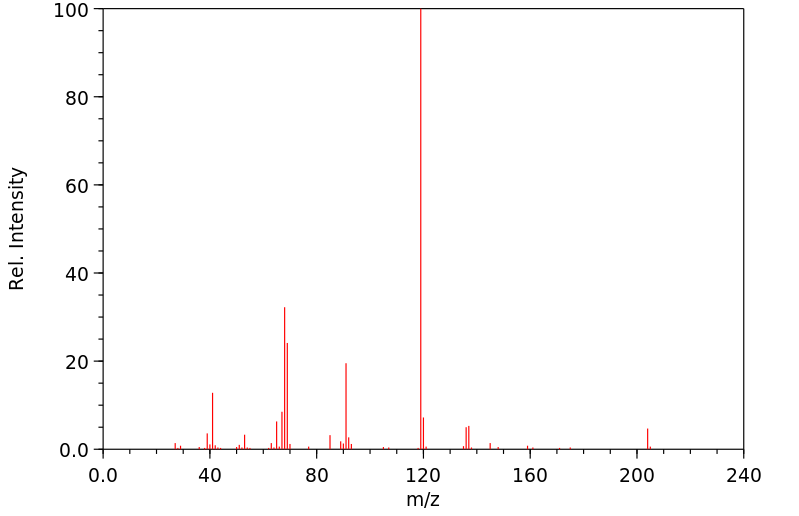3-methylbut-2-enyl 4-methylbenzoate
中文名称
——
中文别名
——
英文名称
3-methylbut-2-enyl 4-methylbenzoate
英文别名
3-Methyl-2-butenyl 4-methylbenzoate
CAS
——
化学式
C13H16O2
mdl
——
分子量
204.269
InChiKey
DTWKHCCYFGKBMV-UHFFFAOYSA-N
BEILSTEIN
——
EINECS
——
-
物化性质
-
计算性质
-
ADMET
-
安全信息
-
SDS
-
制备方法与用途
-
上下游信息
-
文献信息
-
表征谱图
-
同类化合物
-
相关功能分类
-
相关结构分类
计算性质
-
辛醇/水分配系数(LogP):3.6
-
重原子数:15
-
可旋转键数:4
-
环数:1.0
-
sp3杂化的碳原子比例:0.31
-
拓扑面积:26.3
-
氢给体数:0
-
氢受体数:2
上下游信息
-
下游产品
中文名称 英文名称 CAS号 化学式 分子量 对甲基苯甲酸 p-Toluic acid 99-94-5 C8H8O2 136.15
反应信息
-
作为反应物:描述:3-methylbut-2-enyl 4-methylbenzoate 在 Montmorillonite K-10 clay 、 甲苯 作用下, 反应 0.33h, 以95%的产率得到对甲基苯甲酸参考文献:名称:Microwave accelerated selective and facile deprotection of allyl esters catalyzed by Montmorillonite K-10摘要:在无溶剂条件下,使用微波辐照蒙脱石 K-10 从相应的取代烯丙基酯中再生羧酸,与热条件相比,产量提高,反应时间缩短。DOI:10.1039/a909265j
-
作为产物:描述:对甲基苯甲醛 、 异戊烯醇 在 2-巯基丙酸乙酯 、 2,4,5,6-四(9H-咔唑-9-基)异酞腈 、 1,8-二氮杂双环[5.4.0]十一碳-7-烯 作用下, 以 四氢呋喃 为溶剂, 以75 %的产率得到3-methylbut-2-enyl 4-methylbenzoate参考文献:名称:醛/醇与醇的无金属无受体脱氢交叉偶联摘要:尽管在过去十年中,过渡金属催化的脱氢交叉偶联反应在获得碳-碳键和碳-杂原子键方面取得了巨大成功,但无金属无受体的脱氢交叉偶联反应仍然稀缺且非常可取。在这里,我们报告了一种用于碳-杂原子和碳-碳键形成的稳健的无金属无受体脱氢交叉偶联。通过有机光催化剂4CzIPN和硫醇在蓝光照射下的协同催化,醛与醇或两种不同醇的交叉偶联反应顺利进行,具有广泛的底物范围和良好的官能团相容性,以令人满意的收率提供相应的酯类以及氢气的释放。这种无金属的氧化还原中性过程也实现了导致芴酮衍生物的脱氢分子内酰化。机理研究表明,在光催化条件下,酰基会产生并随后氧化成其阳离子。DOI:10.1039/d2gc04594j
文献信息
-
Copper-Catalyzed and Indium-Mediated Methoxycarbonylation of Unactivated Alkyl Iodides with Balloon CO作者:Yanchi Chen、Lei Su、Hegui GongDOI:10.1021/acs.orglett.9b01573日期:2019.6.21This work emphasizes the synthesis of alkyl esters via Cu-catalyzed and In-mediated alkoxycarbonylation of unactivated alkyl iodides in the presence of In or InI. The reactions were suitable for the preparation of primary, secondary, and even tertiary alkyl esters, representing an exceptionally rare example for the creation of quaternary carbon centers upon formation of esters. The preliminary mechanistic这项工作强调在In或InI的存在下,通过Cu催化和In介导的未活化烷基碘的烷氧基羰基化来合成烷基酯。该反应适合于伯,仲,甚至叔烷基酯的制备,代表了在形成酯时生成季碳中心的极为罕见的例子。初步的机理研究表明,涉及烷基自由基,而Cu / In / CO在羰基化事件中起着协同作用。
-
Toluates: unexpectedly versatile reagents作者:Kevin Lam、István E. MarkóDOI:10.1016/j.tet.2009.09.111日期:2009.12The mechanism of the monoelectronic reduction of aromatic esters has been investigated. The unexpected synthetic utility of the toluate moiety in the deoxygenation of alcohols and the allylation of ketones is also reported. Finally, the use of aromatic esters as robust, though easily removable, protecting groups is depicted. (C) 2009 Elsevier Ltd. All rights reserved.
-
Facile Deprotection of Aromatic <i>tert</i>‐Butyl and Allylic Esters Under Microwave Irradiation Conditions作者:Jong Chan Lee、Eun Sang Yoo、Jin Seo LeeDOI:10.1081/scc-200026661日期:2004.1.1A simple and efficient method for the deprotection of tert-butyl and allylic esters is described, which occurs under microwave irradiation with p-toluenesulfonic acid in solvent-free conditions.
表征谱图
-
氢谱1HNMR
-
质谱MS
-
碳谱13CNMR
-
红外IR
-
拉曼Raman
-
峰位数据
-
峰位匹配
-
表征信息
同类化合物
(βS)-β-氨基-4-(4-羟基苯氧基)-3,5-二碘苯甲丙醇
(S,S)-邻甲苯基-DIPAMP
(S)-(-)-7'-〔4(S)-(苄基)恶唑-2-基]-7-二(3,5-二-叔丁基苯基)膦基-2,2',3,3'-四氢-1,1-螺二氢茚
(S)-盐酸沙丁胺醇
(S)-3-(叔丁基)-4-(2,6-二甲氧基苯基)-2,3-二氢苯并[d][1,3]氧磷杂环戊二烯
(S)-2,2'-双[双(3,5-三氟甲基苯基)膦基]-4,4',6,6'-四甲氧基联苯
(S)-1-[3,5-双(三氟甲基)苯基]-3-[1-(二甲基氨基)-3-甲基丁烷-2-基]硫脲
(R)富马酸托特罗定
(R)-(-)-盐酸尼古地平
(R)-(-)-4,12-双(二苯基膦基)[2.2]对环芳烷(1,5环辛二烯)铑(I)四氟硼酸盐
(R)-(+)-7-双(3,5-二叔丁基苯基)膦基7''-[((6-甲基吡啶-2-基甲基)氨基]-2,2'',3,3''-四氢-1,1''-螺双茚满
(R)-(+)-7-双(3,5-二叔丁基苯基)膦基7''-[(4-叔丁基吡啶-2-基甲基)氨基]-2,2'',3,3''-四氢-1,1''-螺双茚满
(R)-(+)-7-双(3,5-二叔丁基苯基)膦基7''-[(3-甲基吡啶-2-基甲基)氨基]-2,2'',3,3''-四氢-1,1''-螺双茚满
(R)-(+)-4,7-双(3,5-二-叔丁基苯基)膦基-7“-[(吡啶-2-基甲基)氨基]-2,2”,3,3'-四氢1,1'-螺二茚满
(R)-3-(叔丁基)-4-(2,6-二苯氧基苯基)-2,3-二氢苯并[d][1,3]氧杂磷杂环戊烯
(R)-2-[((二苯基膦基)甲基]吡咯烷
(R)-1-[3,5-双(三氟甲基)苯基]-3-[1-(二甲基氨基)-3-甲基丁烷-2-基]硫脲
(N-(4-甲氧基苯基)-N-甲基-3-(1-哌啶基)丙-2-烯酰胺)
(5-溴-2-羟基苯基)-4-氯苯甲酮
(5-溴-2-氯苯基)(4-羟基苯基)甲酮
(5-氧代-3-苯基-2,5-二氢-1,2,3,4-oxatriazol-3-鎓)
(4S,5R)-4-甲基-5-苯基-1,2,3-氧代噻唑烷-2,2-二氧化物-3-羧酸叔丁酯
(4S,4''S)-2,2''-亚环戊基双[4,5-二氢-4-(苯甲基)恶唑]
(4-溴苯基)-[2-氟-4-[6-[甲基(丙-2-烯基)氨基]己氧基]苯基]甲酮
(4-丁氧基苯甲基)三苯基溴化磷
(3aR,8aR)-(-)-4,4,8,8-四(3,5-二甲基苯基)四氢-2,2-二甲基-6-苯基-1,3-二氧戊环[4,5-e]二恶唑磷
(3aR,6aS)-5-氧代六氢环戊基[c]吡咯-2(1H)-羧酸酯
(2Z)-3-[[(4-氯苯基)氨基]-2-氰基丙烯酸乙酯
(2S,3S,5S)-5-(叔丁氧基甲酰氨基)-2-(N-5-噻唑基-甲氧羰基)氨基-1,6-二苯基-3-羟基己烷
(2S,2''S,3S,3''S)-3,3''-二叔丁基-4,4''-双(2,6-二甲氧基苯基)-2,2'',3,3''-四氢-2,2''-联苯并[d][1,3]氧杂磷杂戊环
(2S)-(-)-2-{[[[[3,5-双(氟代甲基)苯基]氨基]硫代甲基]氨基}-N-(二苯基甲基)-N,3,3-三甲基丁酰胺
(2S)-2-[[[[[((1S,2S)-2-氨基环己基]氨基]硫代甲基]氨基]-N-(二苯甲基)-N,3,3-三甲基丁酰胺
(2S)-2-[[[[[[((1R,2R)-2-氨基环己基]氨基]硫代甲基]氨基]-N-(二苯甲基)-N,3,3-三甲基丁酰胺
(2-硝基苯基)磷酸三酰胺
(2,6-二氯苯基)乙酰氯
(2,3-二甲氧基-5-甲基苯基)硼酸
(1S,2S,3S,5S)-5-叠氮基-3-(苯基甲氧基)-2-[(苯基甲氧基)甲基]环戊醇
(1S,2S,3R,5R)-2-(苄氧基)甲基-6-氧杂双环[3.1.0]己-3-醇
(1-(4-氟苯基)环丙基)甲胺盐酸盐
(1-(3-溴苯基)环丁基)甲胺盐酸盐
(1-(2-氯苯基)环丁基)甲胺盐酸盐
(1-(2-氟苯基)环丙基)甲胺盐酸盐
(1-(2,6-二氟苯基)环丙基)甲胺盐酸盐
(-)-去甲基西布曲明
龙蒿油
龙胆酸钠
龙胆酸叔丁酯
龙胆酸
龙胆紫-d6
龙胆紫







